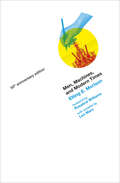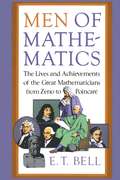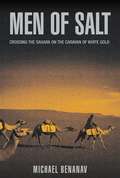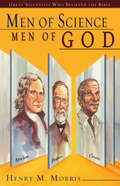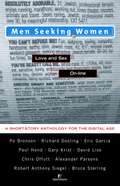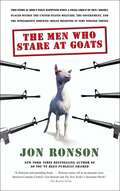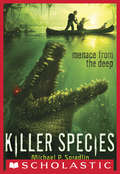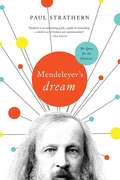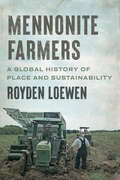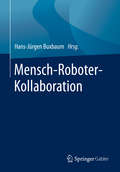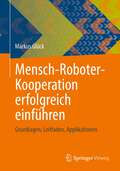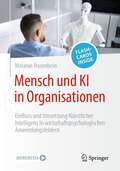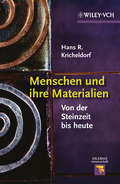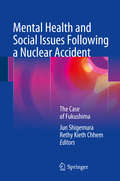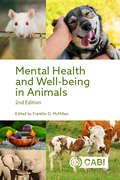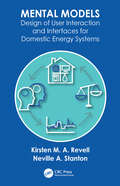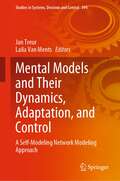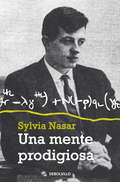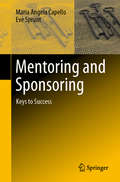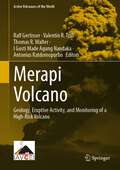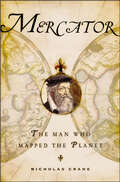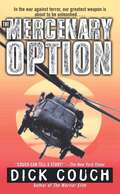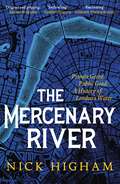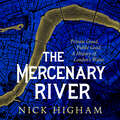- Table View
- List View
Men, Machines, and Modern Times, 50th Anniversary Edition
by Elting E. MorisonAn engaging look at how we have learned to live with innovation and new technologies through history.People have had trouble adapting to new technology ever since (perhaps) the inventor of the wheel had to explain that a wheelbarrow could carry more than a person. This little book by a celebrated MIT professor—the fiftieth anniversary edition of a classic—describes how we learn to live and work with innovation. Elting Morison considers, among other things, the three stages of users' resistance to change: ignoring it; rational rebuttal; and name-calling. He recounts the illustrative anecdote of the World War II artillerymen who stood still to hold the horses despite the fact that the guns were now hitched to trucks—reassuring those of us who have trouble with a new interface or a software upgrade that we are not the first to encounter such problems.Morison offers an entertaining series of historical accounts to highlight his major theme: the nature of technological change and society's reaction to that change. He begins with resistance to innovation in the U.S. Navy following an officer's discovery of a more accurate way to fire a gun at sea; continues with thoughts about bureaucracy, paperwork, and card files; touches on rumble seats, the ghost in Hamlet, and computers; tells the strange history of a new model steamship in the 1860s; and describes the development of the Bessemer steel process. Each instance teaches a lesson about the more profound and current problem of how to organize and manage systems of ideas, energies, and machinery so that it will conform to the human dimension.
Men of Mathematics
by E. T. BellHere is the classic, much-read introduction to the craft and history of mathematics by E.T. Bell, a leading figure in mathematics in America for half a century. Men of Mathematics accessibly explains the major mathematics, from the geometry of the Greeks through Newton's calculus and on to the laws of probability, symbolic logic, and the fourth dimension. In addition, the book goes beyond pure mathematics to present a series of engrossing biographies of the great mathematicians -- an extraordinary number of whom lived bizarre or unusual lives. Finally, Men of Mathematics is also a history of ideas, tracing the majestic development of mathematical thought from ancient times to the twentieth century. This enduring work's clear, often humorous way of dealing with complex ideas makes it an ideal book for the non-mathematician.
Men of Salt: Crossing the Sahara on the Caravan of White Gold
by Michael BenanavIn fact, there was no road at all, just an endless stretch of desert sand called "The Land of Terror" by the nomads who cross it, and described by author Michael Benanav with humor and startling insight in this compelling narrative. Benanav joined what is known as the Caravan of White Gold -- so-called because the salt was once literally worth its weight in gold -- on its mission into the deadly heart of the Sahara to haul back gleaming slabs of solid salt for sale at market. He'd been seized by the idea after coming across an article about the dying days of the caravan: "It was that feeling known by those of us who don't so much take journeys as are taken by journeys: hearing the call of a particular place for a particular purpose that will not be denied. It was the kind of trip I was born to take." Following his amused guide, Walid, Benanav lived for weeks among the camel drivers as they traveled eighteen hours a day for nearly a thousand miles without a map or landmark in sight, through sandstorms and searing heat. Along the way, he learned how to care for and ride camels, became a medic to injured salt miners, and grappled with the dilemmas of cultural extinction created by the ever-widening impact of globalization. MEN OF SALT is a revelation, introducing an important new voice to the tradition of travel literature.
Men of Science Men of God
by Dr Henry M. MorrisOne of the most serious fallacies today is the belief that genuine scientists cannot believe the Bible. THE TRUTH IS that many of the major scientific contributions were made by scientists who were dedicated men of God. In Men of Science, Men of God, Dr. Henry Morris presents 101 biographies which include Christian testimonies of scientists who believed in the Bible and in a personal Creator God . . . scientists who were pioneers and "founding fathers" of modern scientific disciplines. "This is a must for every Christian library, and should be required reading for students." - Baptist Bulletin Dr. Henry M. Morris is the father of modern Creation science, the founder of Institute for Creation Research (ICR) and the author of many well-known apologetic books. His thriving legacy continues to equip Christians to be able to defend the accuracy and authority of Scripture today.
Men Seeking Women; Love and Sex On-line: Love and Sex On-line
by Po BronsonMen Seeking Women: Love and Sex On-line is an exciting and original collection of new short fiction by men about men seeking women, and women seeking men in the digital age. The Internet revolution has altered the look of the traditional relationship. Through e-mail correspondence, chat room chats, and message board postings, the manner in which we meet and mate has drastically changed. While the search for love is a timeless one, how and where we look has never been more a sign of the digital times. Here, ten talented storytellers offer thoroughly contemporary portraits of relationships in the world of new media and high technology in chat rooms, porn sites and other on-line realms. Men Seeking Women is a fresh and unconventional look at the cyber-landscape of love, sex, and companionship.
The Men Who Stare at Goats
by Jon RonsonBizarre military history: In 1979, a crack commando unit was established by the most gifted minds within the U.S. Army. Defying all known laws of physics and accepted military practice, they believed that a soldier could adopt the cloak of invisibility, pass cleanly through walls, and--perhaps most chillingly--kill goats just by staring at them. They were the First Earth Battalion, entrusted with defending America from all known adversaries. And they really weren't joking. What's more, they're back--and they're fighting the War on Terror. An uproarious exploration of American military paranoia: With investigations ranging from the mysterious "Goat Lab," to Uri Geller's covert psychic work with the CIA, to the increasingly bizarre role played by a succession of U.S. presidents, this might just be the funniest, most unsettling book you will ever read--if only because it is all true and is still happening today.
Menace From the Deep (Killer Species #1)
by Michael P. SpradlinA brand-new action-packed series from Michael P. Spradlin. Each book covers a genetically engineered super predator wreaking havoc on the environment.Emmet Doyle is not in the best mood when he arrives in Florida City. His father is a wildlife biologist, and has been summoned to the Everglades, dragging Emmet along with him. Though still in mourning from losing his mom a year ago, Emmet's trying hard to keep a good attitude. Upon their arrival, however, things quickly get weird. Dr. Rosalita Geaux, the Park Superintendent, wastes no time in revealing the reason she called Emmet's father to Florida. A strange creature was recently found dead in the park, and upon seeing it, it becomes clear to everyone that this is not a native species. This is man-made.Deep in the swamp, someone has been experimenting to create a new breed of apex predator. And they're about to set them loose.
Mendeleyev's Dream: The Quest For The Elements
by Paul StrathernThe wondrous and illuminating story of humankind's quest to discover the fundamentals of chemistry, culminating in Mendeleyev's dream of the Periodic Table. In 1869 Russian scientist Dmitri Mendeleyev was puzzling over a way to bring order to the fledgling science of chemistry. Wearied by the effort, he fell asleep at his desk. What he dreamt would fundamentally change the way we see the world. Framing this history is the life story of the nineteenth-century Russian scientist Dmitri Mendeleyev, who fell asleep at his desk and awoke after conceiving the periodic table in a dream-the template upon which modern chemistry is founded and the formulation of which marked chemistry's coming of age as a science. From ancient philosophy through medieval alchemy to the splitting of the atom, this is the true story of the birth of chemistry and the role of one man's dream. In this elegant, erudite, and entertaining book, Paul Strathern unravels the quixotic history of chemistry through the quest for the elements.
Mennonite Farmers: A Global History of Place and Sustainability (Young Center Books in Anabaptist and Pietist Studies)
by Royden LoewenA comparative global history of Mennonites from the ground up.Mennonite farmers can be found in dozens of countries spanning five continents. In this comparative world-scale environmental history, Royden Loewen draws on a multi-year study of seven geographically distinctive Anabaptist communities around the world, focusing on Mennonite farmers in Bolivia, Canada, Indonesia, the Netherlands, Russia, the United States, and Zimbabwe. These farmers, who include Amish, Brethren in Christ, and Siberian Baptists, till the land in starkly distinctive climates. They absorb very disparate societal lessons while being shaped by particular faith outlooks, historical memory, and the natural environment. The book reveals the ways in which modern-day Mennonite farmers have adjusted to diverse temperatures, precipitation, soil types, and relative degrees of climate change. These farmers have faced broad global forces of modernization during the twentieth and early twenty-first centuries, from commodity markets and intrusive governments to technologies marked increasingly by the mechanical, chemical, and genetic. Based on more than 150 interviews and close textual analysis of memoirs, newspapers, and sermons, the narrative follows, among others, Zandile Nyandeni of Matopo as she hoes the spring-fed soils of Matabeleland's semi-arid savannah; Vladimir Friesen of Apollonovka, Siberia, who no longer heeds the dictates of industrial time of the Soviet-era state farm; and Abram Enns of Riva Palacio, Bolivia, who tells how he, a horse-and-buggy traditionalist, hired bulldozers to clear-cut a farm in the eastern lowland forests to grow soybeans, initially leading to dust bowl conditions. As Mennonites, Loewen writes, these farmers were raised with knowledge of the historic Anabaptist teachings on community, simplicity, and peace that stood alongside ideas on place and sustainability. Nonetheless, conditioned by gender, class, ethnicity, race, and local values, they put their agricultural ideas into practice in remarkably diverse ways. Mennonite Farmers is a pioneering work that brings faith into conversation with the land in distinctive ways.
Mensch-Roboter-Kollaboration
by Hans-Jürgen BuxbaumIm Kontext der Industrie 4.0 sind ein wachsender Wettbewerbsdruck, immer größere Anforderungen an Flexibilität und Qualität und immer höhere Ansprüche der Stakeholder wahrnehmbar. In der bekannten Situation des demographischen Wandels entstehen zunehmend neue Assistenzsysteme, insbesondere in der Mensch-Roboter-Kollaboration (MRK). Diese Systeme arbeiten nicht mehr isoliert hinter Zäunen, sondern Hand in Hand mit den Menschen. Sie sollen den Menschen bei monotonen oder kraftraubenden Arbeiten unterstützen oder entlasten. Durch die direkte Zusammenarbeit von Mensch und Maschine rücken Arbeitssicherheit und Ergonomie zunehmend in den Fokus. Klärungsbedarf gibt es bei der Gestaltung von MRK-Arbeitsplätzen und bei der Akzeptanz dieser Arbeitsplätze. Auch neue Aufgabenfelder sind im Gespräch, die sich z.B. in Pflege und Medizin erschließen lassen. Arbeitspsychologie und Human Factors bekommen in der roboterbasierten Automatisierung eine neue, wichtige Bedeutung. Zudem stellt sich die ethische Frage, ob diese neuen Roboter auf längere Sicht den Menschen entlasten oder ersetzen.Hintergrund dieser Veröffentlichung ist der Ladenburger Diskurs der Daimler und Benz Stiftung zum Thema MRK im März 2019. Dieser ist hervorragend besetzt mit einer deutlich interdisziplinären Ausrichtung, die in diesem Thema bislang einmalig ist. Die Teilnehmer sind Autoren dieses Buchs.
Mensch-Roboter-Kooperation erfolgreich einführen: Grundlagen, Leitfaden, Applikationen
by Markus GlückCobots - eine neue Generation an Leichtbaurobotern - unterstützen die Menschen bei der Erfüllung ihrer Produktionsaufgaben; auch im Mittelstand. Doch wie gestaltet man konkret das sichere Miteinander von Menschen und Robotern? Welche Sicherheitskonzepte und Normen gibt es? Wie begegnet man Ängsten? Wen muss man wie „mitnehmen“ auf die Reise in die neue Mensch-Roboter-Ära und was muss man dabei beherzigen? Dieses Buch vermittelt auf anschauliche und pragmatische Weise alles Wissenswerte und Notwendige, um die Mensch-Roboter-Kooperation (MRK) und Cobots rechtssicher im betrieblichen Alltag einzuführen. Es ist ein durchgängiger Leitfaden mit Orientierungshilfen.
Mensch und KI in Organisationen: Einfluss und Umsetzung Künstlicher Intelligenz in wirtschaftspsychologischen Anwendungsfeldern
by Melanie HasenbeinDieses Buch "Mensch und KI in Organisationen" zeigt Ihnen auf, welchen Einfluss die Künstliche Intelligenz und Robotik auf den Menschen in der aktuellen und zukünftigen Arbeits- und Organisationswelt hat. Das Werk nimmt Sie mit auf die Reise der Künstlichen Intelligenz in einzelnen psychologischen und wirtschaftspsychologischen Anwendungsfeldern.Auf der Basis von theoretischem Hintergrundwissen und aktuellen Studien sowie praktischen Umsetzungsmöglichkeiten erfahren Sie:wie Künstliche Intelligenz die Arbeits- und Organisationswelt verändert,was eine Mensch-KI-Interaktion und Mensch-Roboter-Interaktion kennzeichnet,wo KI und Roboter im Human-Resources-Bereich eingesetzt werden,welche zukünftigen Lernszenarien mit KI und Robotern möglich sind,wie eine hybride Führung und Teamarbeit zwischen Mensch, KI und Robotern aussehen kann und welche ethischen Grundsätze beim Einsatz von KI und Robotern zu berücksichtigen sind. Das Buch ist angereichert mit digitalen Fragen und Antworten, die Sie über die Flashcard App zum Selbsttest nutzen können. Die ZielgruppenProfessionals im Organisations- und Personalbereich, Berater, Trainer und CoachesStudierende der Wirtschaftspsychologie sowie der Angewandten und Digitalen Psychologie
Menschen und ihre Materialien: Von der Steinzeit bis heute (Erlebnis Wissenschaft)
by Hans R. KricheldorfWas verandert die Welt? Wer hat denn nun die Welt am starksten verandert: die Politiker, die Ideen in die Tat umsetzten, oder die Philosophen, von denen sie stammten? Oder vielleicht sogar jemand ganz anderes? Etwa der Erfinder des Papiers, ohne das weder Buchdruck noch Reformation denkbar waren? Oder auch diejenigen, die Eisen und Bronze hervorbrachten und damit ganze Epochen begrundeten. Dieses Buch belegt eindrucksvoll: Unsere Geschichte ist immer auch die der Materialien, die wir verwenden. Geschichte neu geordnet Systematisch geht der Autor der Frage nach, wie die Entwicklung von Kulturen und die Moglichkeiten der Materialherstellung zusammenhangen. Er durchstreift die Jahrtausende und setzt dabei bestimmte Zeiten und Materialgruppen zueinander in Beziehung. Dabei beleuchtet er nicht zuletzt spannende Details von Herstellung und Verarbeitung. Alternative Realitaten Und auch Gedankenspielen gibt das Buch Raum, denn die Frage >Was ware wenn?materiellen
Mental Health and Social Issues Following a Nuclear Accident
by Rethy Kieth Chhem Jun ShigemuraThis book focuses on mental health issues arising in the wake of the Fukushima nuclear disaster. Three years after the 11 March 2011 Great East Japan Earthquake, tsunamis, and Fukushima Daiichi nuclear accident, roughly 130,000 individuals continue to face enormous burdens as a result of mandatory evacuation. Many evacuees still live in temporary housing, and returning home remains a distant dream as they wait for the decontamination of the danger zone to be completed. However, the plant recovery process is still evolving, and the complete cleanup will take decades. Beyond all of these hardships, many evacuees are also mourning the loss of their loved ones. The compound disaster with its many uncertainties poses and will continue to pose serious emotional and social challenges. People affected by the nuclear disaster have been facing serious psychological challenges from ongoing fear of radiation exposure. Furthermore, there is continuing debate between various stakeholders on the options for disaster responses. This situation in turn produces adverse public responses, such as discrimination and stigmatization of the evacuees and scapegoating of the authorities and nuclear plant workers. Mental Health and Social Issues Following a Nuclear Accident addresses these issues and their impacts, pursuing both evidence-based and narrative-based approaches. It also contrasts the Fukushima findings with those of other nuclear disasters, namely, Three Mile Island and Cher nobyl.
Mental Health and Well-being in Animals
by Dr Gina Alvino Melissa Bain Ngaio J Ngaio J C. A. Buffington Larry Carbone Kathy Carlstead Sharon Crowell-Davis Dr Victoria Cussen Ian J.H. Duncan Carine Elkhoraibi Daniel Q. Estep Temple Grandin Sophie S. Hall Suzanne Hetts Debra F. Horwitz Gary Landsberg Lori Marino David J. Mellor Professor Michael Mendl Professor Daniel Mills Karen L. Overall Elizabeth S. Paul Pamela J. Reid Claire Ricci-Bonot Lauren M. Robinson Amy Robinson-Junker Lynne M. Seibert David Shepherdson Daniel M. Weary Alexander Weiss Jacqueline Wilhelmy James W. YeatesThe second edition is fully revised, expanded, and comprehensively updated with the most current knowledge about the full array of mental health issues seen in animals. Written by key opinion leaders, internationally-recognized experts and specialists, it is comprehensive covering basic principles to mental wellness, emotional distress, suffering and mental illness, through to measurement and treatment. With even more practical information and clinical pearls, this book remains invaluable to veterinary professionals, animal welfare researchers and advocates, and other animal caregivers.
Mental Models: Design of User Interaction and Interfaces for Domestic Energy Systems
by Kirsten M. Revell Neville A. StantonThere is a resurgence of interest in mental models due to advances in our understanding of how they can be used to help design and due to the development of practical methods to elicit them. This book brings both areas together with a focus on reducing domestic energy consumption. The book focuses on how mental models can be applied in design to bring out behaviour change resulting in increased achievement of home heating goals (reduced waste and improved comfort). This book also offers a method to extract and apply mental models to interface design. The approach enables mental models to be applied across domains when behaviour change was sought, and is validated as a useful design method.
Mental Models and Their Dynamics, Adaptation, and Control: A Self-Modeling Network Modeling Approach (Studies in Systems, Decision and Control #394)
by Jan Treur Laila Van MentsThis book introduces a generic approach to model the use and adaptation of mental models, including the control over this. In their mental processes, humans often make use of internal mental models as a kind of blueprints for processes that can take place in the world or in other persons. By internal mental simulation of such a mental model in their brain, they can predict and be prepared for what can happen in the future. Usually, mental models are adaptive: they can be learned, refined, revised, or forgotten, for example. Although there is a huge literature on mental models in various disciplines, a systematic account of how to model them computationally in a transparent manner is lacking. This approach allows for computational modeling of humans using mental models without a need for any algorithmic or programming skills, allowing for focus on the process of conceptualizing, modeling, and simulating complex, real-world mental processes and behaviors. The book is suitable for and is used as course material for multidisciplinary Master and Ph.D. students.
Una mente prodigiosa
by Sylvia NasarLa magnífica biografía del gran genio John Nash, una obra que recoge lo mejor y lo peor de esta aventura apasionante por los caminos de la genialidad. En 1949, John Forbes Nash era un joven estudiante en Princeton que con su tesis doctoral, dedicada al desarrollo de la teoría de juegos, dio buena muestra de un talento que impresionó a hombres de la talla de Albert Einstein, Robert Oppenheimer y John von Neuman. Más tarde, cuando trabajaba como profesor en el MIT de Cambridge, Massachusetts, se dedicó a investigar y resolver problemas matemáticos de gran envergadura, y en 1994 fue galardonado con el Premio Nobel de Economía. Este currículum, en apariencia impecable, solo nos habla de una parte de la vida de Forbes, pero hay otros aspectos del genio que lo revelan como un hombre hundido en el desamor y perdido entre los fantasmas de la esquizofrenia, una enfermedad que lo mantuvo recluido durante años en clínicas mentales. Hace diez años, Sylvia Nasar siguió paso a paso las peripecias de la turbulenta vida del matemático para entregarnos esta magnífica biografía, que ahora cuenta con un nuevo prólogo de la autora. En ella se recoge lo mejor y lo peor de una aventura vital tan compleja e intrigante como un teorema con rostro humano. Reseñas:«Hay historias que merecen ser contadas y personajes que deberían ser ampliamente conocidos. La historia de la vida del matemático John Forbes Nash es una de ellas.»José Manuel Sánchez Ron, Babelia «Dos párrafos y me enganché.»Oliver sacks
Mentoring and Sponsoring: Keys to Success
by Maria Angela Capello Eve SpruntThis book is a compilation of very personal approaches to mentoring and sponsoring, breaking the stereotypes of seniority, age or experience. The authors have provided a platform to understand that mentoring and especially sponsoring are in fact a win-win relation, in which both sides, mentors and mentees; and sponsors and sponsored individuals learn from each other, enhancing their career paths. How they managed to create a growth space for themselves and their teams through mentoring and sponsoring, is a story of professional leadership. They shared a privileged outlook to understand the root causes of barriers, as well as to envision plausible solutions for difficult career crossroads, in which mentorship or sponsoring was key to steer step changes.The authors propose not only their vision, but a remarkable collection of unfiltered interviews with young and renown professionals in many sectors, from photography to music, research, sports, energy, and more, completing a vision of what is key for both sides of the equation pertinent to mentoring and sponsoring: the givers and the receivers. They explain what is needed to gain the most out of the mentoring and sponsoring loops, with their own career stories.Success is supported by many factors, in which the most important are the technical competency and performance aligned with resilience. However, in the long path of a career, mentors and particularly sponsors play a foundational and frequently a changing-life role, improving our perspective or triggering reflections and actions that benefitted our journeys at work and in life.This book provides insights on what works for an effective mentoring and sponsoring process. It is useful for all professionals, especially those starting their career journeys.
Merapi Volcano: Geology, Eruptive Activity, and Monitoring of a High-Risk Volcano (Active Volcanoes of the World)
by Ralf Gertisser Valentin R. Troll Thomas R. Walter I Gusti Made Agung Nandaka Antonius RatdomopurboThis book provides the first comprehensive compilation of cutting-edge research on Merapi volcano on the island of Java, Indonesia, one of the most iconic volcanoes in the world. It integrates results from both the natural (geology, petrology, geochemistry, geophysics, physical volcanology) and social sciences, and provides state-of-the-art information on volcano monitoring, the assessment of volcanic hazards, and risk mitigation measures.As one of Indonesia’s most active and dangerous volcanoes, Merapi is perhaps best known for its pyroclastic density currents, which are produced by gravitational or explosive lava dome failures (commonly referred to as Merapi-type nuées ardentes). Merapi’s eruptions have posed a persistent threat to life, property and infrastructure within the densely populated areas on the volcano’s flanks, as demonstrated most recently by catastrophic eruptions, which attracted worldwide media interest.
Mercator: The Man Who Mapped the Planet
by Nicholas CraneAn enthralling biography of the man who created the first real map of the world and changed civilizationBorn at the dawn of the age of discovery, Gerhard Mercator lived in an era of formidable intellectual and scientific advances. At the center of these developments were the cartographers who painstakingly pieced together the evidence to create ever more accurate pictures of the planet. Mercator was the greatest of all of them-a poor farm boy who attended one of Europe's top universities, was persecuted and imprisoned by the Inquisition, but survived to coin the term "atlas" and to produce the so-called projection for which he is known. Devoutly religious, yet gripped by Aristotelian science, Mercator struggled to reconcile the two, a conflict mirrored by the growing clash in Europe between humanism and the Church.Mercator solved the dimensional riddle that had vexed cosmographers for so long: How could the three-dimensional globe be converted into a two-dimensional map while retaining true compass bearings? The projection revolutionized navigation and has become the most common worldview.Nicholas Crane-a fellow geographer-has combined a keen eye for historical detail with a gift for vivid storytelling to produce a masterful biography of the man who mapped the planet.
The Mercenary Option
by CouchAfter losing his son in the September 11 attacks, wealthy industrialist Joseph Simpson forms the Intervention Force (IFOR) -- a surgical strike team led by former Navy SEAL Garrett Walker. Officially, the group is a rogue operation with no government affiliation. But when the impossible becomes absolutely necessary, IFOR is... THE MERCENARY OPTION Shortly after the terror attacks on America, the American president announces the construction of an oil pipeline across Afghanistan. To stop this, and deter further Western encroachment in Central Asia, a vindictive Saudi prince retains ex-KGB terror broker Pavel Zelinkow -- a prime mover behind al Qaeda's 9/11 attack. Zelinkow plans to steal two nuclear weapons, detonating one of them among the pipeline construction crews and their military guardians, while the target of the second bomb is a mystery. U.S. special operations forces cannot be used against the terrorists hiding in Iran, so IFOR is called into action for the first time on a mission that will test them to their limits: take out the terrorists, recover the nukes, and get Zelinkow -- dead or alive.
The Mercenary River: Private Greed, Public Good: A History of London's Water
by Nick HighamAnyone interested in the real London needs to read this. - Andrew MarrNo city can survive without water, and lots of it. Today we take the stuff for granted: turn a tap and it gushes out. But it wasn't always so. For centuries London, one of the largest and richest cities in the world, struggled to supply its citizens with reliable, clean water. The Mercenary River tells the story of that struggle from the middle ages to the present day. Based on new research, it tells a tale of remarkable technological, scientific and organisational breakthroughs; but also a story of greed and complacency, high finance and low politics. Among the breakthroughs was the picturesque New River, neither new nor a river but a state of the art aqueduct completed in 1613 and still part of London's water supply: the company that built it was one of the very first modern business corporations, and also one of the most profitable. London water companies were early adopters of steam power for their pumps. And Chelsea Waterworks was the first in the world to filter the water it supplied its customers: the same technique is still used to purify two-thirds of London's drinking water. But for much of London's history water had to be rationed, and the book also chronicles our changing relationship with water and the way we use it. Amongst many stories, Nick Higham's page-turning narrative uncovers the murky tale of how the most powerful steam engine in the world was first brought to London; the extraordinary story of how one Victorian London water company deliberately cut off 2,000 households, even though it knew they had no alternative source of supply; the details of a financial scandal which brought two of the water companies close to collapse in the 1870s; and finally asks whether today's 21st century water companies are an improvement on their Victorian predecessors.
The Mercenary River: Private Greed, Public Good: A History of London's Water
by Nick HighamNo city can survive without water, and lots of it. Today we take the stuff for granted: turn a tap and it gushes out. But it wasn't always so. For centuries London, one of the largest and richest cities in the world, struggled to supply its citizens with reliable, clean water. The Mercenary River tells the story of that struggle from the middle ages to the present day. Based on new research, it tells a tale of remarkable technological, scientific and organisational breakthroughs; but also a story of greed and complacency, high finance and low politics. Among the breakthroughs was the picturesque New River, neither new nor a river but a state of the art aqueduct completed in 1613 and still part of London's water supply: the company that built it was one of the very first modern business corporations, and also one of the most profitable. London water companies were early adopters of steam power for their pumps. And Chelsea Waterworks was the first in the world to filter the water it supplied its customers: the same technique is still used to purify two-thirds of London's drinking water. But for much of London's history water had to be rationed, and the book also chronicles our changing relationship with water and the way we use it.Amongst many stories, Nick Higham's compelling narrative uncovers the murky tale of how the most powerful steam engine in the world was first brought to London; the extraordinary story of how one Victorian London water company deliberately cut off 2,000 households, even though it knew they had no alternative source of supply; the details of a financial scandal which brought two of the water companies close to collapse in the 1870s; and finally asks whether today's 21st century water companies are an improvement on their Victorian predecessors.(P) 2022 Headline Publishing Group Ltd
